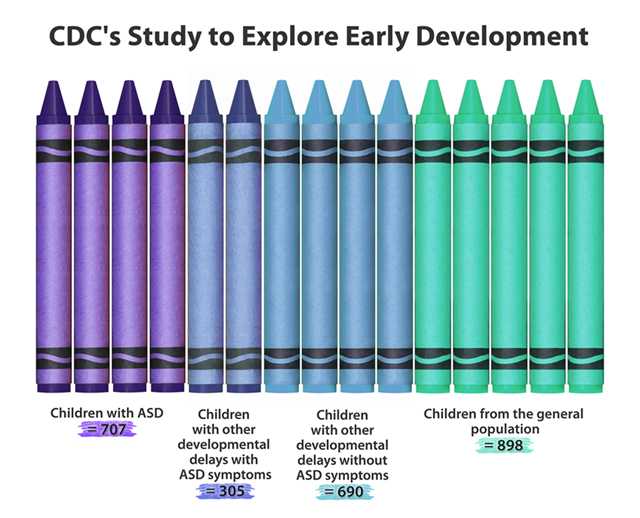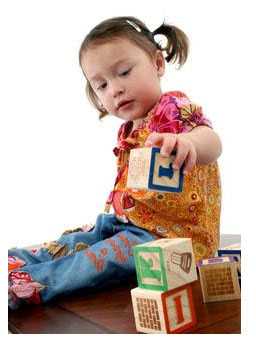Key Findings: Autism symptoms among children enrolled in the Study to Explore Early Development

The Journal of Autism and Developmental Disorders has published a new analysis looking at autism spectrum disorder (ASD) symptoms among young children enrolled in CDC’s Study to Explore Early Development (SEED). Researchers assessed children with ASD, children with other developmental delays, such as language delays and physical delays, and children from the general population. Children with ASD had more problems with early learning, challenging behaviors, and interacting with others than children classified as having other developmental delays. However, some children with other developmental delays had ASD symptoms that posed significant challenges, even though the child did not meet the full criteria needed to be classified as having ASD. These results support the idea that ASD symptoms are found in children both with and without ASD and highlight the many needs of these children and their families. Because the study enrolled children with varying degrees of ASD symptoms, SEED researchers will be able to explore what puts children at risk for ASD and the different ways children may develop ASD.
You can read the abstract of the article here. Read more below for a summary of findings from this article.
Main Findings:
- Children enrolled in the study were classified into one of three major categories after an in-depth assessment: children with autism spectrum disorder (ASD), children with other developmental delays, and children from the general population.
- Children with ASD had more problems with early learning, challenging behaviors, and interacting with others than children in other study groups. Children with ASD were also more likely to have parent-reported vision problems and sensory integration disorder (a condition in which a child has issues receiving and responding to sensory information, such as seeing, hearing, smelling, tasting, and touching) than children in other study groups.
- Children with other developmental delays also had problems with early learning, challenging behaviors, and interacting with others than other children, but at lower levels than children with ASD.
- About a third of children with other developmental delays had some symptoms of ASD, but did not meet the full criteria needed to be classified as having an ASD. For example, the child might avoid eye contact, have little interest in other children, or get upset by minor changes in routine, but still not fit the criteria necessary to be classified as having ASD.
- Children classified as developmental delay with ASD symptoms had more problems with early learning, challenging behaviors, and interacting with others than other children than children classified as developmental delay without ASD symptoms.
- Children classified as developmental delay with ASD symptoms were more likely to have parent-reported attention deficit/hyperactivity disorder (ADHD) than children in other study groups.
- On average, children identified from the general population had early learning abilities within the typical range, and few of the general population children had behavioral or social challenges or parent-reported conditions.
- Overall, these results suggest that the groups of children enrolled in SEED have varying degrees of ASD symptoms. Identifying children with a range of ASD symptoms can help shed light on the different ways children might develop ASD.
About This Analysis
SEED is the largest research study in the United States to help identify factors that may put children at risk for autism spectrum disorder (ASD). The purpose of this analysis was to compare children enrolled in SEED who were classified with ASD with those who were classified with developmental delays and ASD symptoms, developmental delays without ASD symptoms, and those from the general population.
More Information
- CDC’s Study to Explore Early Development: www.cdc.gov/SEED
Key Findings Reference
Wiggins LD, Levy SE, Daniels J, Schieve L, Croen LA, DiGuiseppi C, Blaskey L, Giarelli E, Lee LC, Pinto-Martin J, Reynolds A, Rice C, Rosenberg CR, Thompson P, Yeargin-Allsopp M, Young L, Schendel D. Autism spectrum disorder symptoms among children enrolled in the Study to Explore Early Development. Journal of Autism and Developmental Disorders.
E-mail Your Friends
"Children with autism spectrum disorder are not being diagnosed as early as they could be. Learn the signs of autism and get help if you’re concerned."
Share on Facebook

“Many children with autism spectrum disorder (ASD) are not being identified as early as they could be. Early identification is the most powerful tool we have right now to make a difference in the lives of children with ASD.”
Share on Twitter
“Too many children w/ autism are not being identified as early as they could be. Earlier is better. #ActEarly”
- Page last reviewed: April 28, 2017
- Page last updated: June 8, 2015
- Content source:


 ShareCompartir
ShareCompartir